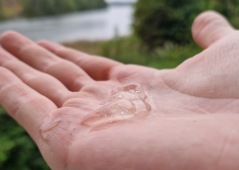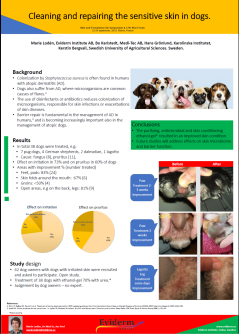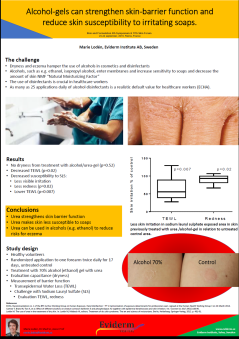Alcohol gel saves skin but kills virus, bacteria and fungus
Development based upon evidence from eczema treatment, sensitive skin and skin penetration
Alcohol based solutions are among the most convenient and widespread aid in the prevention of nosocomial infections. For healthcare workers as many as 25 daily applications of alcohol disinfectants is a realistic default value (ECHA). However, dryness and eczema hamper the use of alcohols in healthcare workers and in ordinary consumers wishing to disinfect their hands. The alcohols not only attack the membranes of the microbes / virus during their elimination, but also enter skin membranes and increase skin sensitivity to other agents, such as soaps.
The development of the present alcohol gel was made by Dr Marie Lodén, who has long experiences from skin research and development of dermatological products, see e.g. the Springer book on The Art and Science of Moisturizers to the right and the publication list from Google Scholar below.
The development of the current alcohol gel was initiated by a veterinarian wishing to disinfect irritated areas on dogs, so called "hot spots", without inducing antimicrobial resistance, while at the same time promote a healthy and barrier-strengthened skin, see the poster to the right.
With the knowledge from eczema and skin barrier research, the natural moisturizer urea (carbamide), niacinamide and propanediol were included into an ethanol-based gel. This pilot gel was clinically proven to improve barrier function, in accordance with previous findings on a medicinal moisturizer with barrier-strengthening properties. The study was published (see below) in the scientific journal Dermatitis.
However, the gel turned out to be unstable and ethylcarbamate (carcinogenic) was detected as an unwanted decomposition product.
Therefore, ethanol was replaced with isopropyl alcohol (IPA), which precludes formation of carcinogenic substances, along with other advantages. This gel has successfully been tested for stability and for biocidal effects.
Ethanol has not yet been approved under the Biocidal Products Regulation (BPR), so the entire range of biocidal products based on ethanol are not yet authorised under the BPR but are available under transitional measures.
The commercial advantage of using IPA instead of ethanol is therefore obvious in the approval process of a biocidal hand sanitizer.
Hand Sanitizer Market
The hand sanitizers are projected for fast growth globally. Drivers for this projection include the coronavirus infection spreading across the globe and measures to prevent the spread of such diseases.
The global hand sanitizer market is expected to reach USD 5.08 billion by 2024, growing at a CAGR of 11.70% over the forecast period 2016-2024, according to Goldstein Research.
The annual market value of hand sanitizers in Europe of US $ 2.32 billion.
The rise in consumer awareness is inducing the demand for hand sanitizers across the public places and even at residential, which is thus driving the growth of the market.
Noteworthy, ethanol is not yet approved under the Biocidal Products Regulation (BPR), so the entire range of biocidal products based on ethanol are not yet authorised under the BPR but are available under transitional measures. The commercial advantage of using IPA instead of ethanol is therefore obvious in the approval process of a biocidal hand sanitizer.
Fulfills Biocidal Requirements for PT1 Hygienic Handrub

The IPA-gel fulfills the biocidal requirement for PT1 Hygienic Handrub criteria (bacteria and yeast) at shortest contact time 30 s in dirty conditions and on skin, as well as for the optional test criteria on certain viruses, such as enveloped viruses (e.g. Covid-Sars, influensa A, herpes virus, RSV, vaccinia), and in non-enveloped viruses (Murine Noro Virus – e.g. winter sickness /vinterkräksjuka).
- EN 14476: virucidal activity against enveloped Modified Vaccinia virus Ankara (MVA), dirty condition (30 sec).
- EN 14476 virucidal activity against non-enveloped Murine Noro Virus (MNV), clean and dirty conditions (60 sec)
- EN 1500: Effective tested on hands on E coli (30 sec)
- EN 13727: Highly effective against bacteria dirty condition (30 sec)
- EN 13624: Highly effective against yeast dirty condition (30 sec)



